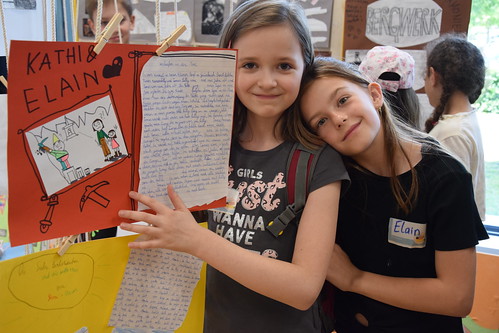“One day there will be …”
Circular Materials Narratives for Futures in the Anthropocene
The seven dwarfs mine coal, Rumpelstiltskin spins straw into gold, but the king's daughter knows that salt is more valuable than gold and precious stones. But burning coal releases CO2 which increases the greenhouse effect and global warming. To feed farm animals with soya instead of straw, the rainforest is cleared. Today, gold is traded on the stock exchange as a crisis-proof investment, whereas salt is no longer considered a valuable substance.
Starting from fairy tales in their material contexts, primary school pupils from Lower Austria explore circular use of resources. As futurologists, the Citizen Scientists explore the knowledge of regional raw materials at their school sites (e.g. coal, graphite, gravel, stone, sand, wood, rapeseed, maize, sugar beet) and research on how the history of mankind can be rewritten for the future as a circular society, in which raw materials are not disposed of as plastic waste, but are reused as valuable materials.
Their research method is the Future Workshop with its three phases, adapted for primary schools. In the first phase the pupils look at the valuable materials in fairy tales. With this new perspective, they go into the circular workshop, and gather knowledge about recyclable materials through excursions to storage sites, interviews with experts, and insights into further processing. In the third phase, the future workshop, they rewrite the fairy tales: "One day there will be ...". The stories about recyclable materials emerge as futures narratives.
The cultural sustainability research conducted with the students focuses on two intertwined questions: How does science communication succeed with the help of material stories? Which teaching-learning processes foster Futures Literacy, the ability to shape sustainable futures? The material cycles and utilisation contexts of regional raw materials researched by the Citizen Scientists serve as data material, as do the material stories for possible futures in the Anthropocene, the 'age of humankind'. In the Anthropocene, the interconnection of humans and nature, culture and technology becomes visible, because the massive interventions of humans bring the earth's systems to their limits. New stories of life in a circular society create appreciation for planet Earth.
This project is already completed.
Final Report
-
Endbericht | "Es wird einmal..." (Opens in new window)(PDF, 230 KB)
Publikation
-
Sippl C.: Zum ästhetischen Potenzial von Bild-Text-Narrationen für Wissenschafts- als Zukünftebildung im Anthropozän (Opens in new window)2025-12-19, „Es wird einmal …“ - Wissen schaffen – Zukünfte erzählen Studien Verlag null189-214Band 17
-
2025-12-10, „Es wird einmal …“ : Wissen schaffen – Zukünfte erzählen StudienVerlag null13-1717
-
Grossar R., Guggenberger S., Kamper R., Sippl C.,: Erste Ergebnisse der Begleitforschung "Es wird einmal..." (Opens in new window)2024-12-05, Symposium "Wissen schaffen - Zukünfte erzählen" Baden
-
Kampe R., Lughammer B., Sippl C.,: Erfahrungen mit Forschung in Volksschulen (Opens in new window)2024-12-05, Symposium "Wissen schaffen - Zukünfte erzählen" Baden
-
Sippl C.,: Mit Zukunftsmärchen kreative Denkräume eröffnen. (Opens in new window)2024-12-05, 4. Grazer Grundschulkongress Graz
-
Kamper R.,: Im Gespräche mit Petra Hauser-Luef (Opens in new window)2024-12-05, #schuleverantworten2023_4
-
Born D., Serifovic A.,: Es wird einmal ... Wertstoffgeschichten für Zukünfte im Anthropozän (Opens in new window)2024-12-05, OIS zam: Forum 2023: "Gemeinsam Wissen schaffen" Linz
-
Sippl C.,: Leitfaden für die Citizen-Science-Forschung an den Volksschulen. (Opens in new window)2024-12-05, Pädagogische Hochschule NOE TRF Baden
-
Kamper R.,: Die Volksschule Bad Fischau-Brunn als Forschungspartnerin im Sparkling-Science-Projekt "Es wird einmal" (Opens in new window)2024-12-05, #schuleverantworten2023_3
-
Sippl C.,: Care for the Planet als kulturelle Aufgabe der Schule im Anthropozän. (Opens in new window)2024-12-05, #schuleverantworten2022_4
-
Kamper R., Lughammer B., Sippl C.: Wertstoffgeschichten erzählen für Zukünfte im Anthropozän. (Opens in new window)2024-12-05, Tagung der Wissenschaftskommunikation in Österreich Graz
 Schools
Schools
 Partners from Economy and Society
Partners from Economy and Society
 Scientific institutions
Scientific institutions










